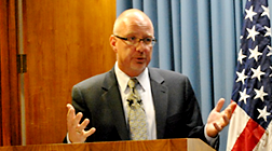AASHTO President Says Collaboration is Essential for Transportation's Health
The United States is at a challenging juncture for transportation infrastructure investment.
"Our transportation system, built largely in the '60s, '70s, and '80s, is deteriorating faster than our ability to keep up," said Kirk T. Steudle, president of the American Association of State Highway and Transportation Officials (AASHTO) and director of the Michigan Department of Transportation. In Michigan alone, the transportation system is deteriorating at a loss of $1 billion a year in asset value.
"We're pushing a huge deficit off to the next generation that we need to take care of now," said Steudle.
Rising construction and rehabilitation costs and the fact that the federal gas tax—transportation's primary funding mechanism—has not been increased since 1993 are adding to the problem of deteriorating infrastructure. Furthermore, state budget shortfalls make it difficult for entities like Steudle's home state of Michigan to provide sufficient money to match available federal funds.
In light of these challenges, it is essential that states and the U.S. Department of Transportation collaborate in order to maintain and improve our transportation infrastructure. "We all have to do this together," said Steudle, speaking during a March 29 "Straight from the Source" presentation at Volpe, The National Transportation Systems Center.
Moving existing research to implementation is a key part of sustaining our transportation system, as exemplified by such programs as the Federal Highway Administration's (FHWA) Every Day Counts initiative, AASHTO's Technology Implementation Group, and the second Strategic Highway Research Program (SHRP2), a comprehensive effort to advance innovative methods for planning, renewing, and operating the nation's highway system.
"SHRP2 really holds a lot of great promise for innovation," said Steudle, who chairs the SHRP2 Oversight Committee. "Most importantly, we are actually putting research to work, and oftentimes, it's with your help," said Steudle, noting that Volpe is very active in supporting the FHWA's implementation of SHRP2.
Resulting from SHRP2 is a broad range of nearly 100 innovative products in four focus areas— Safety, Renewal, Reliability, and Capacity—including new technologies for identifying utilities, non-destructive testing procedures, and pavement preservation approaches for high-traffic-volume roadways.
"But implementing new technologies is never easy because it means change and it means taking a very hard look at how and why we do something and asking ourselves: can we do that better?" said Steudle.
Even if transportation agencies or professionals are not yet prepared to move forward with implementation, it is incumbent on them to stay current on the research—participating in webinars, reading research on the Internet, and viewing video presentations—so that they have the information readily available and can talk about these innovations when the opportunity presents itself.

